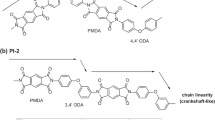Abstract
A series of highly branched poly(urethane–imide) (HBPUI) were synthesized via A2 + B3 approach using isophorone diisocyante (IPDI), polycarbonatediol (PCDL), 3,3′,4,4′-Benzophen-onetetracarboxylic dianhydride (BTDA), and poly(oxyalkylene) triamine (ATA) as materials. The structure of the products was characterized by FT-IR and 13C-NMR. The molecular weights were characterized by gel permeation chromatograph (GPC). The solution viscosity, thermal, and mechanical properties were measured by rotational rheometer, differential scanning calorimetry (DSC), thermal gravimetric analysis (TGA), tensile tests, and dynamic mechanical analysis (DMA), respectively. The HBPUI showed lower viscosity than that of linear poly(urethane–imide) (LPUI), nevertheless T g of HBPUI was higher than that of LPUI. TGA indicated that the thermal degradation of poly(urethane–imide) occurred above 300 °C, which was higher than conventional polyurethane. The tensile strength of HBPUI was obviously improved by increasing the content of BTDA and the molar ratio of [A2]/[B3]. The effects of the content of BTDA and the molar ratio of [A2]/[B3] on the storage modulus of the polymers were also studied.










Similar content being viewed by others
References
Park SH, Chung ID, Hartwig A, Kim BK (2007) Hydrolytic stability and physical properties of waterborne polyurethane based on hydrolytically stable polyol. Colloids Surf A Physicochem Eng Aspects 305:126–131. doi:10.1016/j.colsurfa.2007.04.051
Takeichi T, Ujiie K, Inoue K (2005) High performance poly(urethane–imide) prepared by introducing imide blocks into the polyurethane backbone. Polymer 46:11225–11231. doi:10.1016/j.polymer.2005.09.075
Fabris HJ (1976) Advance in urethane science and technology. Technomic, Westport, CT
Zuo M, Takeichi T (1999) Preparation and characterization of poly(urethane–imide) films prepared from reactive polyimide and polyurethane prepolymer. Polymer 40:5153–5160. doi:10.1016/S0032-3861(98)00726-5
Liu J, Ma DZ, Li Z (2002) FTIR studies on the compatibility of hard-soft segments for polyurethane–imide copolymers with different soft segments. Eur Polym J 38:661–665. doi:10.1016/S0014-3057(01)00247-6
Ghosh MK, Mittal KL (1996) Polyimide: fundamentals and applications. Marcel Dekker, New York
Wilson D, Stenzenberger HD, Hergenrother PM (1990) Polyimides. Blackie, Glasgow
Mishra AK, Chattopadhyay DK, Sreedhar B, Raju KVSN (2006) FT-IR and XPS studies of polyurethane-urea-imide coatings. Prog Org Coat 55:231–243. doi:10.1016/j.porgcoat.2005.11.007
Liao DC, Heich KH (1994) Synthesis and characterization of bismaleimides derived from polyurethanes. J Polym Sci Part A Polym Chem 32:1665–1672. doi:10.1002/pola.1994.080320908
Sendijavic A, Sendijavic V, Frisch KC (1990) Synthesis and properties of urethane-modified polyimides. J Polym Sci Part A Polym Chem 28:3603–3615. doi:10.1002/app.1983.070s281126
Wang TL, Huang FJ (1998) Synthesis and properties of poly(amide–imide–urethane) thermoplastic elastomers. Polym Int 46:280–284. doi:10.1002/(SICI)1097-0126(199808)46:4<280:AID-PI992>3.0.CO;2-#
Yeganeh H, Barikani M, Khodabadi NF (2000) Synthesis and properties of novel thermoplastic poly(urethane–imide)s. Eur Polym J 36:2207–2211. doi:10.1016/S0014-3057(99)00284-0
Lee TJ, Lee DJ, Kim HD (2000) Synthesis and properties of liquid crystalline polyurethane elastomers. J Appl Polym Sci 77:577–585. doi:10.1002/(SICI)1097-4628(20000718)77:3<577:AID-APP13>3.0.CO;2-X
Radlmann E, Koehler A, Nischk G (1971) Polyurethane elastomers with polyimide or ployamic structure for highly elastic filaments/films. DE2017511
Jeon JY, Tak Tae M (1996) Synthesis and characterization of block copoly(urethane–imide). J Appl Polym Sci 62:763–769. doi:10.1002/(SICI)1097-4628(19961031)62:5<763:AID-APP7>3.0.CO;2-U
Salah HAA (1991) Synthesis and properties of poly(urethane–urea–imide) block copolymers. Polym J 23:815–821. doi:10.1295/polymj.23.815
Nair RP, Nair CPR, Francis DJ (1999) Effect of imide-oxazolidinone modification on the thermal and mechanical properties of HTPB-polyurethanes. J Appl Polym Sci 71:1731–1738. doi:10.1002/(SICI)1097-4628(19990314)71:11<1731:AID-APP2>3.0.CO;2-M
Patel HS, Vyas HS (1991) Poly(urethane–imide)s. Eur Polym J 27:93–96. doi:10.1016/0014-3057(91)90132-8
Patel HS, Vyas HS (1992) Kinetic studies on epoxy resins cured with a novel polyamine. High Perform Polym 4:41–48. doi:10.1088/0954-0083/4/1/005
Jena KK, Chattopadhyay DK, Raju KVSN (2007) Synthesis and characterization of hyperbranched polyurethane–urea coatings. Eur Polym J 43:1825–1837. doi:10.1016/j.eurpolymj.2007.02.042
Cheng KC, Chuang TH, Chang JS, Guo WJ, Su WF (2005) Effect of feed rate on structure of hyperbranched polymers formed by self-condensing vinyl polymerization in semibatch reactor. Macromolecules 38:8252–8257. doi:10.1021/ma050640s
Chen A, Yao C, Zeng S, Yi C, Xu Z (2008) Preparation and properties of hyperbranched polyurethanes via oligomeric A2 + bB2 approach. Polym Bull 61:363–371. doi:10.1007/s00289-008-0959-x
Spindler R, Fréchet JMJ (1993) Synthesis and characterization of hyperbranched polyurethane prepared from blocked isocyanate monomers by step-growth polymerization. Macromolecules 26:4809–4813. doi:10.1021/ma00070a013
Feast WJ, Rannard SP, Stoddart A (2003) Selective convergent synthesis of aliphatic polyurethane dendrimers. Macromolecules 36:9704–9706. doi:10.1021/ma035511v
Clark AJ, Echenique J, Haddleton DM, Straw TA, Taylor PC (2001) A noniscocyanate route to monodisperse branched polyurethanes. J Org Chem 66:8687–8689. doi:10.1021/jo016075i
Kricheldorf HR, Schwarz G (2003) Cyclic polymers by kinetically controlled step-growth polymerization. Macromol Rapid Commun 24:359–381. doi:10.1002/marc.200390063
McKee MG, Unal S, Wilkes GL, Long TE (2005) Branched polyesters recent advances in synthesis and performance. Pro Polym Sci 30:507–539. doi:10.1016/j.progpolymsci.2005.01.009
Gao C, Yan D (2003) “A2 + CBn” approach to hyperbranched polymers with alternating ureido and urethane units. Macromolecules 36:613–620. doi:10.1021/ma021411y
Gao C, Yan D (2004) Hyperbranched polymers from synthesis to applications. Pro Polym Sci 29:183–275. doi:10.1016/j.progpolymsci.2003.12.002
Abdelrehim M, Komber H, Langewalter J, Brigitle V, Bruchmann B (2004) Synthesis and characterization of hyperbranched poly(urea–urethane)s based on AA*and B2B* monomers. J Polym Sci Part A Polym Chem 42:3062–3081. doi:10.1002/pola.20154
Fornof AR, Glass TE, Long TE (2006) Degree of branching of highly branched polyurethanes synthesized via the oligomeric A2 plus B3 methodology. Macromol Chem Phys 207:1197–1206. doi:10.1002/macp.200600096
Acknowledgments
The research was supported by Innovation Group Foundation and Elitist Foundation of the Provincial Science & Technology Department, Hubei, China.
Author information
Authors and Affiliations
Corresponding author
Rights and permissions
About this article
Cite this article
Liu, D., Zeng, S., Hu, Q. et al. Synthesis and properties of highly branched poly(urethane–imide) via A2 + B3 approach. Polym. Bull. 64, 877–890 (2010). https://doi.org/10.1007/s00289-009-0178-0
Received:
Revised:
Accepted:
Published:
Issue Date:
DOI: https://doi.org/10.1007/s00289-009-0178-0




